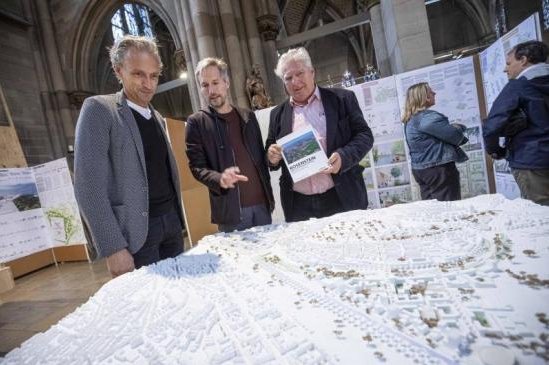 Decentrally generated electricity from renewable energies can cover the demand for electrical energy in Bavaria both in balance and in perspective. This is the result of a joint study by the grid operators Bayernwerk Netz GmbH (Bayernwerk), LEW Verteilnetz GmbH (LVN) and Main-Donau Netzgesellschaft. The Bavarian power grid operators have analysed which development paths are possible for Bavaria with regard to renewable power generation and whether climate neutrality can be achieved in the power sector. The grid operators received scientific support from the Forschungsstelle für Energiewirtschaft e.V. (Research Centre for Energy Economics).
Decentrally generated electricity from renewable energies can cover the demand for electrical energy in Bavaria both in balance and in perspective. This is the result of a joint study by the grid operators Bayernwerk Netz GmbH (Bayernwerk), LEW Verteilnetz GmbH (LVN) and Main-Donau Netzgesellschaft. The Bavarian power grid operators have analysed which development paths are possible for Bavaria with regard to renewable power generation and whether climate neutrality can be achieved in the power sector. The grid operators received scientific support from the Forschungsstelle für Energiewirtschaft e.V. (Research Centre for Energy Economics).
Study describes four scenarios
The current study follows on from the previous study from 2015 and describes the future development of renewable electricity generation in Bavaria. In four scenarios, the forecasts for wind and photovoltaic systems on buildings and open spaces are available in high regional resolution. The two scenarios "Interconnection" and "Regional Generation" look up to the year 2060 and assume complete climate neutrality of electricity generation in Bavaria. This requires a considerable increase in the number of photovoltaic and wind power plants. However, a CO2-neutral electricity supply cannot be achieved if the expansion trend of the last three years is merely continued (Trend scenario) or if the current federal policy framework (Policy scenario) is used as a basis.
Distribution grids as the backbone of a decentralised energy supply system
"We need even more dynamism in the expansion of electricity generation from renewable energies if we want to achieve the idea of a climate-neutral energy supply," says Egon Westphal, technical director of Bayernwerk. "The distribution grids have a central role to play in this. They will continue to be the stable backbone of a decentralised energy supply in the future. The people of Bavaria can rely on this", says Dr. Egon Westphal.
In addition to the further integration of renewable plants into the electricity grid, the foreseeable increase in demand on the electricity grids as a result of new applications such as electromobility will also remain a central task. Through grid expansion, the use of innovative technologies as well as digitalisation and flexibilisation in generation, consumption and storage, the distribution grid operators see themselves well equipped for these tasks. "We can additionally optimise the necessary grid expansion if we can access flexibility options in generation, consumption and storage in a grid-serving manner," explained Dr Egon Westphal. In addition, the distribution grid operators will further intensify their cooperation in order to be able to ensure the safe and efficient operation of the electricity grids in the future as well.
In 2060, green electricity generation may exceed consumption in Bavaria
The two scenarios "interconnection" and "regional generation" are particularly important with regard to climate policy goals. The interconnection scenario assumes a strong nationwide exchange of electricity via transmission lines - the most economical scenario in terms of cost optimisation under today's conditions. In the "Regional Generation" scenario, on the other hand, green electricity is preferably generated locally in Bavaria. In both scenarios, around 60 TWh of green electricity will already be generated in 2030, rising to around 85 TWh in 2060. If current electricity consumption is extrapolated, this amount would cover around 80 percent of electricity consumption in 2030. In 2060, Bavaria's green electricity plants will produce significantly more electricity than is consumed. In perspective, there will be enough renewable electricity available for the electrification of new applications such as electromobility, the expansion of heat pumps or power-to-X measures.
Strong growth in photovoltaics
An important component in both scenarios is the strong expansion of photovoltaic plants: the installed PV capacity on buildings increases from currently 9,500 MW to 21,100 MW in 2030 and 32,400 MW in 2060. In the interconnection scenario, ground-mounted plants also record a significant increase, from currently 3,000 MW to 10,000 MW (2030) and 25,200 MW (2060). While in the regional scenario the expansion of ground-mounted systems is somewhat more restrained, wind power plays a more important role here. The scenario describes an increase in wind power from currently 2,800 MW to 5,700 MW (2030) and 9,300 MW (2060).
Wind power with regional focus
In the regional scenario, the strongest addition of wind power plants occurs in Lower Franconia with +1,500 MW. However, sites in the southern administrative districts (Lower Bavaria: +1,200 MW and Swabia: +1,100 MW) must also be developed in order to achieve the climate protection targets. In the other administrative districts, the expansion amounts to between 550 and 650 MW. In contrast to wind power, the expansion of ground-mounted systems is distributed more evenly across all administrative districts. With 2,300 MW, the largest addition is in the largest administrative district, Upper Bavaria.
More than 60 percent of Bayernwerk's grid is already made up of renewables.
Almost 300,000 plants feed electricity from renewable energies into the Bayernwerk grid, mostly from photovoltaics. In total, these systems have an output of almost 9,000 megawatts. Bayernwerk thus already transports more than 60 percent renewable energy in its grids. The most important energy sources are photovoltaics, hydropower and biomass. Wind plays a subordinate role.
Source: PM of Bayernwerk et al. from 28.11.2019.
Keywords: 100% EEs, Citizen Energy, CO2-neutral, DE-News, Renewable, Research, Climate protection, Media, Tenant electricity, Sustainable management, New books and studies, News Blog Bavaria, PV, PlusEnergy house/settlement, Environmental policy, eMobility, Life cycle assessment, Ecology






